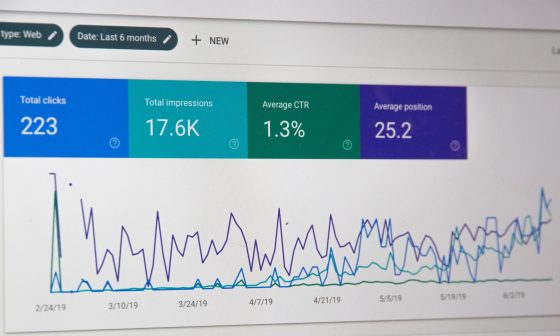Automation and AI can feel like something you’d rather avoid or not get to know any better than you already do, especially with everything else that’s keeping you busy. But the truth is, you can offload a big chunk of your SEO workflow to AI, boosting output and team productivity. The trick is knowing which tasks to automate and which to leave to good old human insight.
Unfortunately, most small to mid-sized agencies waste a lot of working hours manually running audits, building briefs, working on meta tags, and other grunt work AI can seamlessly do (even faster, cheaper, and more accurately). SEO managers spend a whopping 40 hours per week on repeatable tasks, many of which can now simply be waved away through the magic of ~automation. As a result, 66% admit that they don’t end up with enough time to truly focus on profit-generating and strategic work.
Let’s see what a smarter, AI-powered SEO workflow looks like in action.
TL;DR: Top SEO Workflows You Can Automate with AI
- Automate repeat SEO tasks like article drafts, internal linking, metadata, and weekly reports to save time and improve consistency.
- Start small, automate one boring task (e.g., content briefs), then build out your workflow with checkpoints and review layers.
- Parts of SEO that you can automate include:
- Draft content: Use tools like Scalenut, SEOwind, Outranking, and Simplified. Go from keyword to first draft in under 15 minutes.
- Fix technical SEO: Use tools like Alli AI and SearchAtlas. Automate meta updates, broken links, schema markup, and audits.
- Structured content: Use ChatGPTs for structured SEO tasks like rewriting meta tags, generating alt text, or summarizing crawl data.
- Map topic clusters: Use Frase, ContentGecko, or SearchAtlas. These tools auto-group keywords and generate brief templates in bulk.
- Automate internal linking: Linkter AI can crawl your site and recommend contextually relevant anchor text between pages. Automate link-building outreach using Pitchbox. Personalize at scale, run follow-ups, and track replies from one dashboard.
- Track rankings and send auto-reports: Use SE Ranking, SearchAtlas, or ContentGecko. You don’t have to keep exporting spreadsheets every week!
- Set up feedback loops: Use Clearscope, Frase, or SurferSEO. These tools grade your drafts as you optimize and let you see areas to work on.
What Counts as an AI-Automated SEO Workflow?
In simple terms, these are repeatable tasks of SEO optimizations, such as initial research, content creation, and performance analysis. These tasks are all handled by AI tools and automation platforms like ChatGPT, Zapier, Make, or n8n. They help you define the rules, and the tech does the busy work.


SEO automation with AI frees SEO specialists from the mundane tasks and lets them focus on strategy, branding, and conversion optimization. It’s an area many agencies are curious about, but few feel ready to jump into with full confidence.
Benefits You Can Measure
- Speed: AI-powered audits are faster than manual checks.
- Scale: They help you easily handle SEO for 100+ locations or websites with templated workflows.
- Accuracy: Tools like Alli AI improve accuracy in detecting metadata and schema issues at scale.
- Savings: Agencies can save up to 25 hours/month per client when automating technical SEO tasks.
Finally, (and this is the part most agencies love) they’re surprisingly easy to implement.
Technical SEO Audits & Auto-Fixes
You’re wasting time if you’re still running audits by hand or fixing metadata one page at a time, manually. Here are some top workflow automation templates built to help act on or simplify everyday tasks.
1. Alli AI
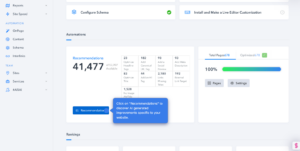
Source: Alli AI
Alli AI is a hands-free technical SEO tool that helps businesses optimize search presence.
It works directly on live websites (including Shopify, WordPress, and custom HTML), injecting meta, schema, and internal links via their Smart Code Snippet, with no need for a developer.
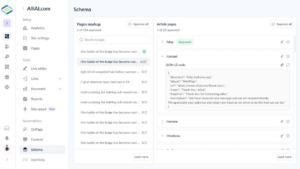
(Alli AI’s schema markup generator)
Alli essentially transforms your CMS into an AI-based recommendation tool, making it an especially powerful tool if you’re running an agency.
What it Automates
- Title tag, meta description, and header tag fixes across 100s of pages
- Internal link rule creation (e.g., link all pages with “roofing” to /roofing-adelaide)
- Schema injection for LocalBusiness, FAQ, and Breadcrumb markup
Sample Workflow:
Automated Internal Linking for Service Pages
- Tools: Alli AI (paid), n8n (free)
- Flow:
- Crawl your sitemap weekly using Alli AI
- Identify keyword-rich phrases with low internal link count
- Auto-insert contextual links based on predefined rules
- Update sitemap and ping Google
- Setup time: ~1 hour
This automation can, for instance, help a 30-location HVAC business increase organic traffic by at least 20% in 3 months, with no extra writing.
2. SearchAtlas (SEO Toolkit)

Source: Search Atlas
SearchAtlas is an advanced all-in-one SEO platform for creating content, auditing sites, analyzing competitors, and more. It crawls, fixes, and optimizes features in one SaaS dashboard. Their Core Web Vitals module flags speed issues and suggests Lighthouse-based fixes.
What it Automates
- Daily technical audit reports
- Schema.org markup generation
- Meta tag compliance with Google best practices
- Redirect map building after URL changes
Sample Workflow:
Automated Redirect & Broken Link Management
- Tools: SearchAtlas (Pro plan)
- Flow:
- Scan all 404s and orphan pages daily
- Generate redirect map (.csv export)
- Sync with your CMS or hand over to the dev team
- Result: It can reduce bounce rate from broken links by 15–30% aligning you with industry benchmarks.
This is important if you’re migrating domains or fixing legacy SEO issues.
3. ChatGPT (GPT-4)
Yes, ChatGPT can also automate technical SEO workflows, primarily when used with tools like Screaming Frog, Google Sheets, and Zapier.
And no, it’s not just for content. When you feed it structured audit data, it can generate accurate, readable fixes that your team or client can implement directly.
What it Automates
- Rewrite missing or duplicate meta titles using SERP data
- Suggest ALT tags based on image file names and page context
- Generate schema markup (FAQ, LocalBusiness, Product)
- Convert crawl exports into plain-English recommendations
Workflow Example:
- Meta description rewrite: “Rewrite these meta descriptions under 160 characters, using target keywords and natural language”
- Export crawl data to CSV
- Prompt ChatGPT with “Rewrite the following meta titles under 60 characters, with target keywords”
- Review and paste output into the bulk upload sheet for CMS
- Optional: Send to client via Notion board or email
- Time saved: 2–3 hours per 100 pages, with minimal review edits for multi-location brands
4. n8n (No-Code Automation Platform)
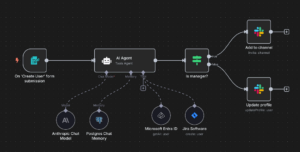
Source: n8n
n8n is the secret tool behind many of SEO workflows. It works a bit like Zapier, connecting SEO tools, Google Sheets, Slack, webhooks, and more, with no code required.
What it Automates
- Scheduled crawls, exports, and email summaries
- Trigger-based updates (e.g., when a page’s status code changes)
- SEO task reminders and approval chains
- Data syncing between tools like Screaming Frog, ChatGPT, and CMS platforms
Workflow Example:
- Weekly Audit Summary + Team Alert
- n8n triggers a crawl every Monday via API
- Filters high-priority errors (e.g., duplicate H1s, missing meta)
- Generates summary doc
- Sends via Slack and uploads to a Notion dashboard
Note: Free plan available, open-source, with over 800 app integrations.
Content Gap Analysis & Topic Cluster Planning
Planning your content around vague topic ideas means you may be leaving topical authority on the table.
You can let AI structure your blog strategy, based on what your competitors rank for and what your site lacks.
1. Frase.io
You know the deal by now: The average user’s search behavior has completely shifted. They begin conversations and ask questions. Frase.io has its finger on the pulse of this revolution. Frase scrapes top SERPs and builds content briefs using a super advanced NLP-driven AI model. It scores competitor pages and recommends headers, keywords, FAQs, and sources.
What it Automates
- Competitor comparison for each keyword
- Title and H2 suggestions based on SERP data
- Internal linking paths for clustered topics
- Keyword clustering by search intent
- Pinpoint voice search trends
- FAQ optimization
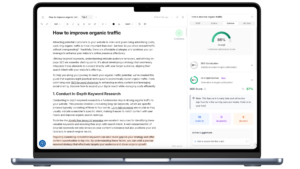
Source: Frase
Sample Workflow:
Automated Topic Cluster Brief Generator
- Tools: Frase (paid), Google Sheets, Zapier (free tier works)
- Flow:
- Add keyword list to Google Sheets
- Zapier pushes each keyword to Frase
- Frase auto-generates content brief + outline
- Files saved to Google Drive and Slack-notified
- Time saved: Up to 8 hours per 10 briefs
2. SearchAtlas (Content Planner)

Source: SearchAtlas
SearchAtlas has a Cluster Builder tool that groups 200+ keywords into logical silos and assigns them to hub or spoke pages. Clustered content drives more impressions than unclustered articles, and SearchAtlas can help you get on top of this task.
What it Automates
- Keyword clustering using semantic AI
- Suggests internal link structures
- Maps topic coverage gaps
- Assigns content roles based on user intent
Workflow Example:
Cluster Campaign for “Local Pest Control”
- Inputs: 200 keywords
- Outputs: 12 topic clusters
- e.g., “Rodent Control” > “Mouse Traps,” “Signs of Infestation,” “Rat vs Mouse”
- Results: Content plan with 12 pillar blogs, 28 support articles, and linking map
Time to plan: 15 minutes flat.
3. ContentGecko
While less mainstream, ContentGecko is helpful in early-stage research and editorial workflow automation. Here’s why it works so well: You begin the whole process by supplying the complete picture of your business. From the moment it’s activated, GeckoAI gets to work: scanning your writing style, existing content, and keywords, and building a rich, contextual understanding.
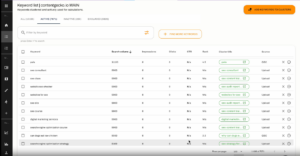
Source: ContentGecko
What it Automates
- AI-driven SERP outline building
- Search intent tagging
- Internal/external resource recommendations
- Competitor structure mapping
- SEO-optimized content generation
Sample Workflow:
Outline Approval Workflow
- Tools: ContentGecko (paid), Gmail, Notion
- Flow:
- Input keyword into dashboard
- ContentGecko builds outlines, FAQs, title tags, and meta descriptions
- Email outline to client via Gmail
- Client approval auto-triggers card move in Notion
- Time saved: 20–30 minutes per outline
Draft Generation & On-Page Optimization
If you’re still writing outlines or metadata manually, you’re burning a lot of time better spent on strategy. Modern AI tools can now generate article drafts, optimize on-page SEO, and write alt text that aligns with user intent.
Tools to Use
Scalenut, SEOwind, Simplified, and Outranking are all tested and trusted tools for generating first drafts and optimizing your on-pages.
Each of these tools uses NLP models trained on top-ranking SERPs. They pull structure, suggest headers, and provide AI-generated content ready for editing.
What You Can Automate
- Blog outlines and full draft generation
- Meta titles, meta descriptions, and slugs
- Image alt-text generation based on context
- FAQ schema-ready questions and answers
How It Works (Step-by-Step with Scalenut):
- Input a target keyword or phrase
- Scalenut scans the top 30 SERP results
- Generates H1, H2s, and an optimized outline
- Uses NLP to generate a 600 to 1,500-word draft
- Suggests metadata and alt tags
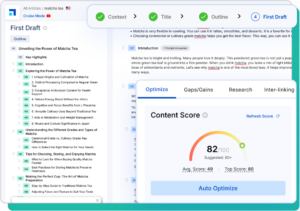
Source: ScaleNut
You’ll still need to edit for voice and fact accuracy, but the first draft can be wrapped up in under 15 minutes. For agencies juggling multiple blog calendars, that’s a huge reduction in content prep time.
Today, no conversation about SEO is complete without talking about Generative Engine Optimization (GEO). Most search engines now feature GenAI outputs prominently. Just look at Google’s “AI Overview” sitting atop the SERP.
With tools like Scalenut, you can create content that AI and LLMs like ChatGPT, Claude, and Gemini actually cite. Plus, you can track your GEO scores and quickly fix any gaps in the system.
Useful Custom GPTs
The following are some of the most useful GPTs for creating SEO-friendly content without losing clarity or quality:
Semantic Context Search Agent GPT: This is an easy and effective GPT to zero in on search intent.
Your content cannot be stuffed with keywords; it has to make sense. This GPT uses a blend of NLP, machine learning, and data analysis to begin contextualising content early on to make everything smoother down the line.
How To Use
- Search intent analysis
- Filtered keyword suggestions
- Generate titles to connect to user intent
Semantic SEO Writer GPT: Choosing to blindly generate “SEO” content will probably never work out as intended. But you can simplify the process a little with this GPT. Beginning your drafting process with this tool means you can nail your formatting and organization on the first try, avoiding any revisions later.
How To Use
- Balanced keyword usage
- Structured headings that follow SEO guidelines
- Semantic optimization
NLP Friendliness GPT: Writing for the purpose of SEO can often result in content that feels abstruse. If this balancing act is proving to be too much to handle, this GPT works to make content (especially first drafts) sound more natural and feel easy on the eyes.
How To Use
- Adjusting content for conversational tone
- Natural flow and increased engagement
Internal Linking Automation
Internal links help SEO and keep users engaged, and improve crawlability. But manually linking pages is tedious and error-prone.
Now, AI can identify internal linking opportunities based on semantic relevance, anchor text, and site structure. It suggests and even implements these links, helping you build better silos without spreadsheets.
Tool to Use: Linkter AI
Linkter uses AI to scan your entire site and recommends contextual internal links based on entity matching and semantic proximity.
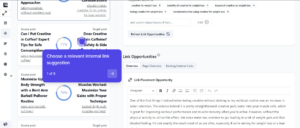
Source: Linkter AI
What You Can Automate
- Suggest internal anchor text across 100+ blog pages
- Link relevant product or location pages inside blog posts
- Fix orphan pages by suggesting relevant entry points
- Implement changes automatically or send to review
Sample Workflow with Linkter AI:
- Crawl your blog content weekly using Linkter
- The tool suggests 3 to 5 internal links per article
- Approve or set auto-insert rules (e.g., all mentions of “novated lease” link to /car-leasing-australia)
- Tool injects links directly via plugin or script
- Export reports for clients showing changes
For multi-location businesses, this ensures each location page gets proper link equity, something often overlooked in local SEO.
Remember: Pages with internal links from high-authority content rank higher by up to 40 percent, especially in competitive niches.
Automated Reporting & Rank Tracking
Clients want to see progress. But weekly reports, audit summaries, and rank tracking updates take hours to compile.
That’s what automated dashboards and SERP monitors can help with. They gather real-time data, compile it into readable reports, and schedule sends so you won’t have to pull numbers on a Monday morning before your client calls.
Tools to Use
SE Ranking, ContentGecko and SearchAtlas are highly regarded for automated reporting and rank tracking.
These platforms offer keyword tracking, audit insights, and site visibility changes, all from a clean dashboard.
What You Can Automate
- SERP position tracking across desktop and mobile
- Keyword movement summaries (with thresholds and tags)
- Site audit snapshots with technical errors and fixes
- Monthly or weekly reports, white-labeled with your logo
- AI-overview tracking
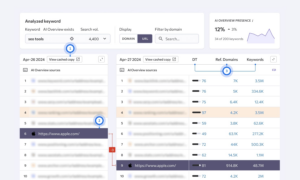
(SE Ranking’s AI Overview tracking)
How It Works (With SE Ranking)
- Set up a project and input keywords
- Tool tracks rankings across Google and Bing
- Assign tags like “buy intent” or “local target”
- Every Monday, a report lands in your inbox
- Sync with Google Looker Studio for client dashboards
If you’re managing 5+ client sites, this workflow saves about 8–10 hours per week, without having to export .csv files or write audit recaps from scratch.
Content Optimization Feedback Loops
So you’ve written a draft. But is it optimized? Will it rank? Does it match search intent?
Content grading tools now give live feedback during writing. They score your content, highlight gaps, and suggest on-page improvements based on competitor performance.
Tools to Use
Clearscope, SurferSEO, and ContentGecko are tools that help to compare your draft against top-ranking pages for the same keyword. They measure content relevance, keyword coverage, and formatting.
- SurferSEO works best in environments with a high volume of content creation. This includes content hubs and agencies tackling long-form content. In addition to functioning as an NLP engine, Surfer makes recommendations based on SERP data and embeds seamlessly with Google Docs.
- Clearscope effectively balances SEO elements with that human touch. The tool quickly audits top-ranking SERP competitors and shows you exactly how to realign your content for success. You’ll get a brief modeled on what’s already winning, complete with target keywords, ideal word count, and the semantic terms shared by top-performing pages.
- ContentGecko navigates seamlessly between old, new, and updated content. The tool also offers many integration options (including with Autoblog, WordPress, Notion, and CMS) to publish content automatically. The resulting content is based on deep-research insights and a unique business-based SEO strategy.
What You Can Automate
- NLP-based topic suggestions
- Grading content based on search intent and depth
- Highlighting missing terms or headers
- Real-time readability scoring
Example Workflow (With SurferSEO):
- Paste your draft into SurferSEO’s editor
- Get a score from 0 to 100 based on keyword and topic coverage
- Tool suggests terms like “air condition needs,” “air conditioning unit,” “air conditioner,” or “air conditioning” based on SERP trends
- Accept changes, adjust headers, and improve clarity
- Recheck score until you hit 85+
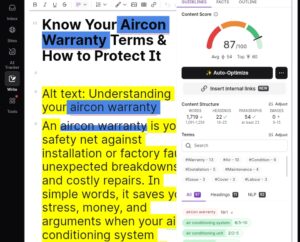
Source: SuferSEO
For teams managing writers or outsourcing content, this becomes a feedback loop at scale, keeping every post on-brand and on-topic.
Outreach & Link-Building Workflow Automation
Whether you’re chasing guest posts, resource page mentions, or digital PR links, the reality is that outreach eats up more time than most SEO teams can spare.
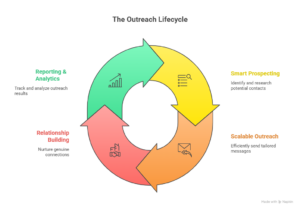
Tool to Use: Pitchbox
If you’ve ever sent 50 cold emails for backlinks, you know how mind-numbing outreach can be. Finding sites, writing personal intros, and sending follow-ups: you know it’s a full-time job.
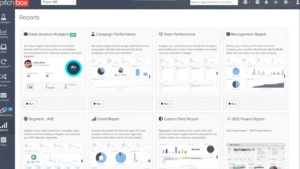
Source: Pitchbox
You dig through Google, find 50 sites, write custom pitch emails, then follow up three times, and maybe get one reply, if you’re lucky. Pitchbox automates the dirty work but still lets you sound human.
What Pitchbox Handles for You
- Finding sites worth pitching
- Customizing outreach emails using dynamic fields (like first name or article title)
- Running follow-up sequences without you babysitting them
- Tracking opens, clicks, replies, and live opportunities
How to Set it Up
- Choose a campaign type: guest post, broken link, or resource page
- Enter a keyword or niche topic
- Pitchbox pulls sites from multiple sources
- Build your pitch template with custom tags like {{blog_name}}
- Set up follow-ups (e.g., Day 3 nudge, Day 7 final reminder)
- Watch leads roll in or tweak the messaging based on replies
Let’s say you manage a local SEO campaign for 10 roofing clients. You want to source backlinks from construction blogs, real estate sites, and service directories. A manual outreach campaign would take you 15–20 hours a week. With Pitchbox, you can get the same volume done in under 3 hours and still have time to debrief with your team or take Friday off.
How Others Are Using SEO Automation
Not every workflow comes neatly packaged with a SaaS tool. Some marketers are building clever little automations using no-code tools like n8n, Gumloop, and Make.
N8N is an open-source option that’s cheaper but way harder to integrate into your workflow and run. Gumloop, however, is easy to build, easy to run, but it’s a little more expensive.
Still, you’d be surprised what you can set up without writing a line of code.
SEO Brief Generator Using n8n
One Redditor shared a clever n8n automation setup they built for a Dutch client, and it’s seriously next-level.
Here’s how it works, step by step:
- The user enters a keyword into an n8n form
- n8n uses the Google Custom Search API to scrape trending article links
- Each article is then passed through the APIFY text extractor API to pull clean text
- That content is fed to a GPT-4 model, which drafts a document brief for the next agent
- A second AI agent picks up the keyword + brief, and writes a 1500-word article draft
- A final AI agent runs the draft through a humanizer model to make it sound more natural
The entire thing runs autonomously, and from what the poster shared, it cuts hours off the content creation process. This is ideal if you’re producing bulk SEO blogs for clients or want to build your own done-for-you content machine.
Gumloop
Gumloop is one of those “must-try” automation tools, simply because of how much it can do for you.
Primarily, the tool helps you set up AI agents with a no-code (yay!) interface. Gumloop lets you automate marketing, sales, and operational workflows, and its core advantage is eliminating the need for an engineering team to create internal AI tools.
You can design and deploy custom AI agents for tasks like automating keyword research, generating SEO content briefs, and streamlining reporting.
The tool can also connect Search Console, OpenAI, and Sheets to fix underperforming metadata in bulk.
- It pulls blog URLs with low CTR from Search Console
- Sends them to OpenAI to rework meta titles and descriptions
- Then updates a Google Sheet with fresh ideas for review
- You (or your junior) can paste them into the CMS
This is a great way to freshen up 50+ old posts in one swoop and get them climbing the SERPs again.
Make
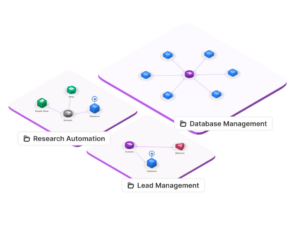
Source: Make
Make is a go-to for agency teams who want alerts and not just reports. Here’s what you can automate with Make:
- Run site audits weekly via Ahrefs or Screaming Frog
- Pull top keyword changes from Google Search Console
- Get alerts in Slack when something spikes or tanks
- Share a visual report with clients without logging into multiple tools
Most of these flows are available as templates, so you don’t need to reinvent the wheel. Moreover, they’re dead simple to tweak once you get the hang of them.
How to Build Your First AI-Driven SEO Workflow
Trying to automate everything at once is a quick way to burn out. You can start with one process that feels repetitive, boring, or way too time-consuming.
Step 1: Pick a high-volume pain point
Look at your week. What SEO task makes you roll your eyes? Some ideas:
- Manually writing meta tags
- Pulling keyword ranking reports
- Creating content briefs
- Fixing broken links across dozens of pages
Pick the one you hate the most.
Step 2: Choose a workflow to test
Let’s say you go with content briefs. Here’s what a flow might look like:
- Input keyword into a sheet
- Auto-pull SERP competitors and headers
- Generate H1, H2, and FAQ ideas
- Save to a doc and notify your writer
You can do all that with n8n and Gumloop in under an hour.
Step 3: Build it out
- Use Gumloop’s drag-and-drop builder
- Connect your tools (Docs, Sheets, Search Console, OpenAI)
- Follow a template or watch a YouTube walkthrough
- Run a few test flows to see if it works clean
Step 4: Add review checkpoints
Automation doesn’t mean letting your entire workflow run wild. You can set up review steps like:
- “Approve outline before writing”
- “Check meta descriptions before publishing”
- “Review backlink target before sending pitch”
These keep quality high and make sure nothing silly slips through.
Step 5: Check what’s changing
After a couple of weeks, ask:
- Did this save time?
- Was the output actually usable?
- Did rankings or click-throughs improve?
There is no point in automating junk. Make sure it’s helping you get better results.
Wrap-Up
SEO doesn’t have to be so hands-on. If you’re spending 10 hours plus each week on tasks like metadata, briefs, or reporting, that’s a sign. Automate the boring bits and keep your brainpower for strategy, revenue generation, or other tasks that move the needle.
If you need a hand pulling this all together, Synup can build that harmony. We help businesses and agencies simplify customer acquisition and SEO at scale, with automation-friendly tools and local visibility baked in.
Try one workflow this week. Seriously. Even if it saves you just 3 hours, that’s an entire client call or strategy session you’ve now got back.
That’s what working smarter actually looks like. You’ll wonder how you ever did it all manually.
FAQs
-
Which AI is best for automation?
That depends on what you want to automate. OpenAI is great for content generation. But for actual workflow building, tools like Gumloop, n8n, or Make are the best. You’ll want something that connects to your stack without needing a dev.
-
Can I use AI to do my SEO?
You can use it to handle the boring parts like briefs, meta, and monitoring. But you still need real humans for strategy, link-building, and editing. You should see AI as your intern. It can fetch the coffee, but shouldn’t run the campaign.
-
What is the best AI to assist with SEO?
There is honestly not a lot of all-in-one tools whose overall efficiency is worth vouching for. You need a combo. For instance:
- Gumloop can help with workflow building
- OpenAI for content generation
- Frase.io or SurferSEO for content grading
Mix them based on your process and the type of clients you manage.
-
How to automate SEO with AI?
Pick one small workflow. Use a no-code tool to test it, add review layers, measure performance, then rinse and repeat. However, don’t jump into full-scale automation until you know what works.


